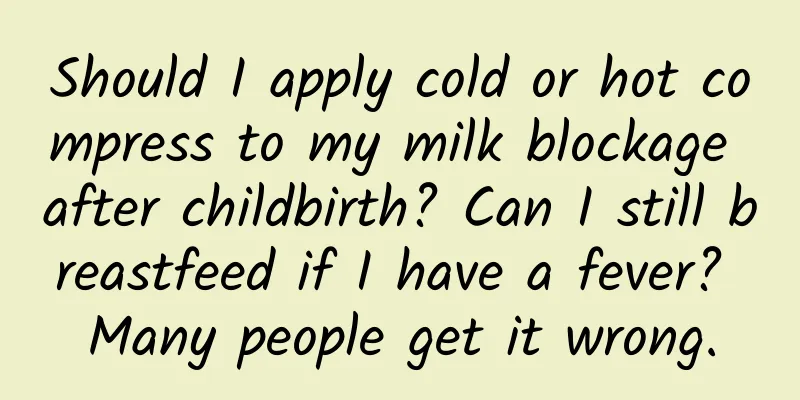Should I apply cold or hot compress to my milk blockage after childbirth? Can I still breastfeed if I have a fever? Many people get it wrong.

|
Author: Li Guangjun, Chief Nurse, Beijing Obstetrics and Gynecology Hospital, Capital Medical University Reviewer: Song Jiangli, Director of the Science Popularization Department of the Chinese Nursing Association For postpartum mothers with excessive milk, milk blockage is a very common phenomenon. If not treated in time, it may further develop into mastitis. Today we will share with you some common problems about milk blockage. 1. If you have milk blockage after childbirth, should you apply cold or hot compress? If it is simply milk blockage and milk stasis, without symptoms of redness, swelling, heat or pain, hot compress is needed. Hot compress can expand the mammary ducts, and combined with massage, it can promote milk discharge. Here’s how: Get a basin of warm water at about 30-40℃ and use a hot towel to apply heat to the breasts. Apply heat to each breast for about five or six minutes at a time, and alternately apply heat to the two breasts for about 20 minutes. After the heat, massage, and then let the child suck the breasts desperately. Figure 1 Original copyright image, no permission to reprint If your breasts become soft after your baby finishes sucking, it means the milk has been emptied and that's all. If the breasts do not become soft after the baby has finished sucking, it means there is still milk in them and you need to express the milk manually or use a breast pump to suck out the milk from the breasts. Emptying the breasts is the most fundamental measure to prevent mastitis. If mastitis has already occurred and symptoms of redness, swelling, heat and pain have appeared, especially in the acute stage, do not apply hot compresses, because hot compresses at this time will aggravate the spread of inflammation and further aggravate mastitis. At this time, you can use cold compress, which can shrink the milk ducts, relieve swelling and pain, lower the temperature of the skin, and thus increase comfort. 2. If my milk is blocked after childbirth and I have a fever, can I still breastfeed? Whether or not to breastfeed depends on the situation. If the body temperature does not exceed 38℃, it is generally physiological swelling and you can breastfeed your baby. What you need to do at this time is to dredge the mammary ducts and suck out the milk. The first choice is to let the baby suck, the second is to express milk manually, and the last is to use a breast pump to suck milk. Figure 2 Original copyright image, no permission to reprint If the above measures are taken, the mammary ducts are unblocked and the milk is sucked out, the body temperature will drop in about 24 hours and the breast pain will disappear. If there is no improvement after implementing these measures, and the fever is as high as 39°C or even 40°C, mastitis may have occurred. Be sure to go to the hospital for diagnosis in time to see if antibiotics or antipyretics are needed. In the case of medication, whether breastfeeding can be done cannot be generalized. For example, if penicillin or cephalosporin is used, breastfeeding can generally be continued. If metronidazole or sulfonamide is used, breastfeeding needs to be temporarily stopped. Therefore, the principle of medication is to follow the doctor's orders first. You cannot take medication on your own. Whether you can breastfeed your child depends on the specific medication used. 3. What should we pay special attention to in order to prevent milk blockage after childbirth? After giving birth, the first thing to do is "early contact". Now it is immediately. That is, after the baby is born, before the baby is treated in any way, let the baby lie on the mother. This is immediate, and at the same time, early sucking must be achieved. What does early sucking mean? Generally, a child will have a feeding reflex after lying on the mother for about 15 minutes, at which time the child can be allowed to suck the breast, so early skin contact and early sucking are the first point. The second point is frequent and effective sucking, frequent means no less than 8-12 times in 24 hours. At the same time, pay attention to breastfeeding at least 2-3 times at night, and don't leave the baby to others at night. The third point is to ensure the correct feeding and sucking posture. In this process, it is also necessary to prevent nipple cracking, because nipple cracking may affect breastfeeding to a certain extent and easily cause milk stasis. Fourthly, when choosing underwear, you must choose loose cotton ones, and the bra should not be too tight, otherwise it will affect blood circulation and may also cause compression of the mammary ducts, leading to milk congestion. Fifth, when sleeping or lying in bed, try to change your body position. Don’t always maintain the same position, because this may cause pressure on some mammary ducts or breasts, and may also cause milk congestion. In addition, some mothers have relatively large breasts, and the milk ducts under the breasts are easily wrinkled and blocked like water pipes, which can also cause local milk congestion. Therefore, mothers with large breasts need to hold up their breasts when breastfeeding. Also be careful when supporting the breasts. Do not use the scissor-style support, as it can easily compress the mammary ducts. Use the C-shaped support instead. The C-shape can straighten the mammary ducts. This is the way to support the breasts during feeding. The other thing is to pay attention to a light diet and strengthen nutrition. For example, eat more fruits, vegetables, meat, eggs, milk, and avoid eating spicy or fried foods. Figure 3 Original copyright image, no permission to reprint Finally, I would like to emphasize that some people say that lard can promote milk secretion, but this actually has no scientific basis, so don’t eat too much lard, and try to eat less foods that are particularly high in fat. |
>>: CMR: India's high-end smartphone shipments grew 18% year-on-year in the first half of 2020
Recommend
When is the best time to open the fallopian tube?
When the fallopian tubes are blocked, it will ind...
How to fade the black below
It is normal for women to have dark skin down the...
Small fleshy lumps on the vulva that do not hurt or itch
The growth of small grains on the vulva is genera...
Causes of dark menstrual blood
There are many things that women need to pay atte...
What is the reason for brown discharge from a girl?
Brown discharge is caused by female vaginal bleed...
What causes cervicitis?
Many people do not have a clear understanding of ...
How parents deal with ADHD in children
This is the 4792th article of Da Yi Xiao Hu Atten...
Pregnant women always can't sleep all night
Sleep quality is actually very important for preg...
Will pregnancy with a syringe cause deformity?
Being pregnant and becoming a mother is a very ha...
What to do if pregnant woman is hungry at night
We all know that after a woman becomes pregnant, ...
What is the cause of small bumps in the vulva?
Sometimes women often experience discomfort in th...
No more skin test for ceftriaxone? This article will help you understand the key points of skin test
Penicillin and cephalosporin (also known as β-lac...
Is acid reflux and vomiting a sign of pregnancy?
People who have acid reflux must pay attention to...
December 2024 "Science" Rumors List: Is standing office healthier than sitting office? Fruits should not be heated before eating?
The list of "science" rumors in Decembe...









